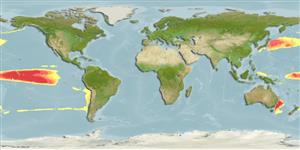>
Lophiiformes (Anglerfishes) >
Oneirodidae (Dreamers)
Etymology: Oneirodes: Greek, 'oneiros' = a dream or dreamlike or out of a dream (suggesting this fish is so strange and marvelous that can exist only in dreams) (Ref. 86949).
Environment: milieu / climate zone / depth range / distribution range
Ecología
marino batipelágico; rango de profundidad 840 - 1030 m (Ref. 86949). Deep-water
Pacific Ocean: known from the type locality, 0°01'N, 139°06'W (Ref. 46206). Also north of Marquesas Islands and Line Islands (Ref. 86949).
Tamaño / Peso / Age
Maturity: Lm ? range ? - ? cm
Max length : 3.5 cm SL macho / no sexado; (Ref. 36336)
Short description
Claves de identificación | Morfología | Morfometría
Radios blandos dorsales (total) : 6; Radios blandos anales: 4. Characterized by having escal morphology: esca with stout, internally pigmented anterior appendage, distal end is bifurcated bearing numerous unpigmented tapering filaments; three pairs of filamentous medial escal appendages, most anterior pair longest, almost as long as escal bulb; terminal escal papilla rounded with distal streak of pigment; unpigmented tapering posterior escal appendage, slightly expanded and trifurcated at distal tip; absence of lateral escal appendages; stout, unpigmented anterolateral escal appendage bearing few small filaments; subopercle without indentation on posterodorsal margin; length of ventral fork of opercle; 21.4-23.8% SL; ratio of lengths of the dorsal and ventral forks of opercle 0.38-0.47; absence of epibranchial teeth; presence of teeth on pharyngobranchial II; upper jaw teeth 20-65, lower jaw teeth 27-70; teeth on vomer 4-8; dorsal fin rays 6; anal fin rays 4; pectoral fin rays 16-17; head length 35.7-38.1% SL; head depth 37.1-38.6% SL; premaxilla length 25.7-31.7% SL; length of lower jaw 38.1-38.6% SL; length of illicium 35.7-60% SL (Ref. 86949).
Life cycle and mating behavior
Madurez | Reproducción | Puesta | Huevos | Fecundidad | Larva
Orr, J.W., 1991. A new species of the ceratioid anglerfish genus Oneirodes (Oneirodidae) from the western North Atlantic, with a revised key to the genus. Copeia 1991(4):1024-1031. (Ref. 36336)
IUCN Red List Status (Ref. 130435: Version 2024-2)
Threat to humans
Harmless
Human uses
Herramientas
Special reports
Download XML
Fuentes de Internet
Estimates based on models
Preferred temperature (Ref.
123201): 1.4 - 1.6, mean 1.6 °C (based on 34 cells).
Phylogenetic diversity index (Ref.
82804): PD
50 = 0.5000 [Uniqueness, from 0.5 = low to 2.0 = high].
Bayesian length-weight: a=0.01995 (0.00906 - 0.04395), b=3.01 (2.83 - 3.19), in cm total length, based on all LWR estimates for this body shape (Ref.
93245).
Nivel trófico (Ref.
69278): 3.4 ±0.6 se; based on size and trophs of closest relatives
Resiliencia (Ref.
120179): Alto, población duplicada en un tiempo mínimo inferior a 15 meses (Preliminary K or Fecundity.).
Fishing Vulnerability (Ref.
59153): Low vulnerability (10 of 100).
